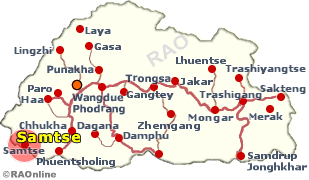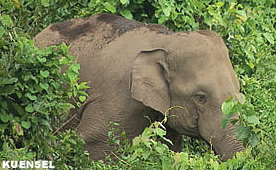| Bhutan's
Nature - Animals |
 |
Bhutan Nature Animals |
 |
Bhutan Information |
|
|
 |
| Wild elephants in Southern Bhutan |
| Wild Elephants in Samtse |
 |
 |
|
Seasonal elephant-visitors to the country from across the Indian border spend longer time in Bhutan, a study the forestry officials recently did revealed.
The study conducted in 2010 in Samtse, Sarpang and Phipsoo estimates about 110 elephants in Samtse and 380 in Sarpang and Phipsoo wildlife sanctuary.
The data were mobilised through collection of dung samples.
|
|
The reason, foresters said was the availability of large patches of forests and absence of threat from poaching they were traumatised about.
About 1,500 sqkm along the southern borders, from Dhansirichu in the east to Sipsu, Samtse, in the west, along the Indo-Bhutan border, is home to the elephants mostly migrants from India.
They migrate from thick forests in Bhutan to grasslands in India during winter, between November and April and return to Bhutan in the summer, from May to October.
 |
| Wild elephants have become a nuisance to farmers in South Bhutan |
|
"Undisturbed sub-tropical forests, vast expanse the southern foothills characterises and availability of food have made these areas attractive to elephants," forestry officials said. "It’s true especially during green seasons."
During such times, forest officials said presence of elephants weighed heavily on farmers in terms of destruction of crops and properties.
|
|
In the last few years, reports of destruction of crops, property and threat to lives by wild elephants increased in the southern districts, bringing many of the rural livelihoods into direct conflict with wildlife. The worst recorded was in 2005, when about 265 acres of cropland in seven gewogs of Sarpang was destroyed.
In 2007 wild elephants destroyed 132 acres of crops that include maize, paddy, millet, banana, and nut trees.
Samtse alone recorded nine cases of property and crop damages by the elephants this year.
On January 5 this year, a farmer in Samtse reported damage to 45 banana trees, two betel nut trees, 40kg cattle feed including damages to a cattle shed and the stoned wall around the field.
Another farmer in Samtse, on January 25 lost 50kg maize, 50kg millet and five banana trees and his neighbour complained of losing 350kg millet and 25 banana trees to the elephants.
"So far, we’ve never compensated farmers for their losses the elephants caused them," chief forestry officer under Nature Conservation Division Sonam Wangchuk said.
As a mitigation measure, he said, solar electric fence worth about Nu 10M was erected along the southern borders with introduction of a human wildlife endowment fund.
"Besides being expensive, electric fencing has also proved to be ineffective due to poor maintenance and theft," the division officials said.
Mitigation measures to reduce conflict also included equipping staff with guns for blank fire.
 |
| Contributed by KUENSEL, Bhutan's national newspaper, 2012 |
top
| Wildlife and People in Bhutan |
 |
| Information on Bhutan |
 |
| Links |
 |
|




